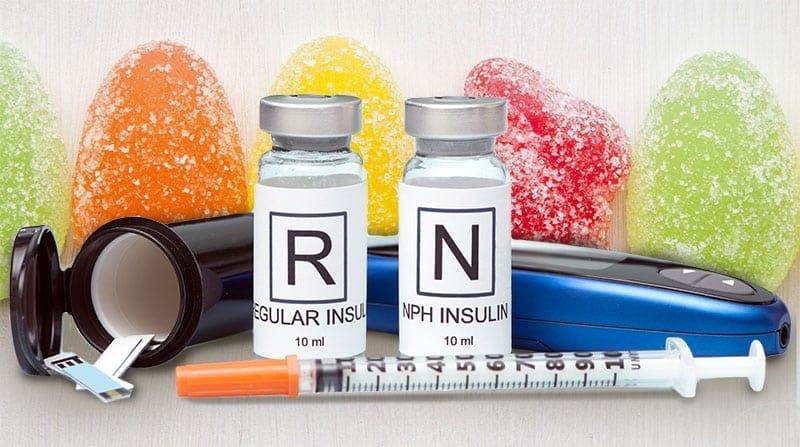Diabetes is a metabolic disorder that affects 20.8 million Americans. The trouble begins when blood glucose levels become elevated. This is due to a lack of sufficient insulin production, or the body failing to recognize and use the insulin properly. Very serious health complications can result from diabetes, especially if left untreated.
Glycation is one unwelcomed result of elevated blood glucose. By the same process that allows food to brown in an oven, sugar molecules in the body may bind with proteins to form advanced glycation end products (AGEs). While usually benign, high levels of AGEs can lead to nerve and organ damage, elevated cholesterol levels, and even sexual dysfunction.
What Causes Diabetes?
Every time you eat, your body converts food into glucose (sugar) to fuel cells for energy. In order for this process to work, insulin, a hormone produced by the pancreas, must be present to transport glucose from the blood to the cells. In people who produce little or no insulin, glucose builds up in the blood instead. When blood sugar remains too high, headache, blurry vision, dull skin, and frequent urination are sure to follow.
There are two major types of diabetes – type I and type II. The former, also known as diabetes mellitus, or juvenile onset diabetes, is an autoimmune disorder in which the immune system attacks and destroys insulin-producing beta cells in the pancreas. It’s not clear why this cellular genocide occurs, but it’s believed that abnormal antibodies, and possibly viral infections, may be involved. Type I accounts for 5-10% of diagnosed diabetes, occurring most commonly in children and young adults, and requires daily insulin intake. Without this intervention, the body is forced to break down fats for energy, a process that produces ketones (waste products) in the blood, which can result in diabetic ketoacidosis, a highly toxic state that can lead to a life-threatening coma.
In Type II, or adult onset diabetes, the pancreas may produce adequate insulin, but for some reason the body ignores it, setting up insulin resistance. In response, the pancreas pumps out even more insulin to force glucose into the cells, resulting in elevated blood glucose. This form of diabetes is more common, occurring in up to 95% of diabetics and is associated with age, family history, obesity, and certain ethnic groups. The good news is that type II is largely preventable–even reversible–with proper care.
While having a sweet tooth isn’t necessarily a precursor to diabetes for most people, a sensible diet low in fat and refined sugar does provide resistance. According to Ruchi Mathur, MD, Assistant Professor of Medicine at the Keck School of Medicine, University of Southern California, “It’s a matter of smaller portion sizes more than anything else. Some people go to extremes by avoiding starches, but it doesn’t work that way.” Instead, she recommends limiting simple carbohydrates such as sodas, breads and pastas made from white flour and other highly processed foods.
Double the Trouble
More than half those living with diabetes can eventually expect to experience neuropathy, a tingling sensation (or lack of any feeling) in the extremities brought on by insufficient blood flow. In severe cases, especially when coupled with untreated ulceration, bone infection can occur and lead to the need for amputation.
Nephropathy, or kidney disease, is another complication of diabetes that is characterized by the presence of too much albumin (protein) in the urine. Unfortunately, this usually remains undetected until too much damage has occurred, possibly renal failure. However, elevated blood pressure and triglyceride levels are often early warning signs.
According to the American Diabetes Association, 12,000 to 24,000 annual cases of blindness are reported in diabetic patients ranging 20-74 years of age, primarily due to damage to eye vessels by high blood glucose levels. Eventually, lipid infiltration and deformed blood vessels attack and destroy the retina.
Awareness is key to the prevention of this disease, especially since the occurrence of diabetes in children and adults is rising on an epidemic scale. The Center for Disease Control reports that from 1980 through 2004, the number of Americans diagnosed with diabetes more than doubled – from 5.8 million to 14.7 million. By 2010, this number is expected to reach 221 million. At the time of this writing, 6.2 million people are walking around with diabetes and don’t even know it.
Did You Know?
Heart disease and stroke account for about 65% of deaths in people with diabetes.
About 73% of adults with diabetes have high blood pressure.
Mexican Americans are almost twice as likely and non-Hispanic blacks are almost 50% as likely to develop diabetic retinopathy as non-Hispanic whites.
About 60% to 70% of diabetics have mild to severe forms of nervous system damage.
More than 60% of non-traumatic lower-limb amputations occur in diabetics.
In 2002, 44,400 diabetics began treatment for end-stage renal disease (ESRD) and a total of 153,730 people were living on chronic dialysis or with a kidney transplant.
Source: American Diabetes Association
ADW Diabetes is the Only diabetic supply store you will ever need!
We offer diabetic supplies affordable to everyone, save up to 60% on all your supplies.
ADW offers the best prices and service for all your diabetic supply needs!
Please Contact Us if you have any questions, suggestions or comments. We DO want you to be 100% satisfied and you can be sure that we will go that extra mile for you.







Leave A Comment